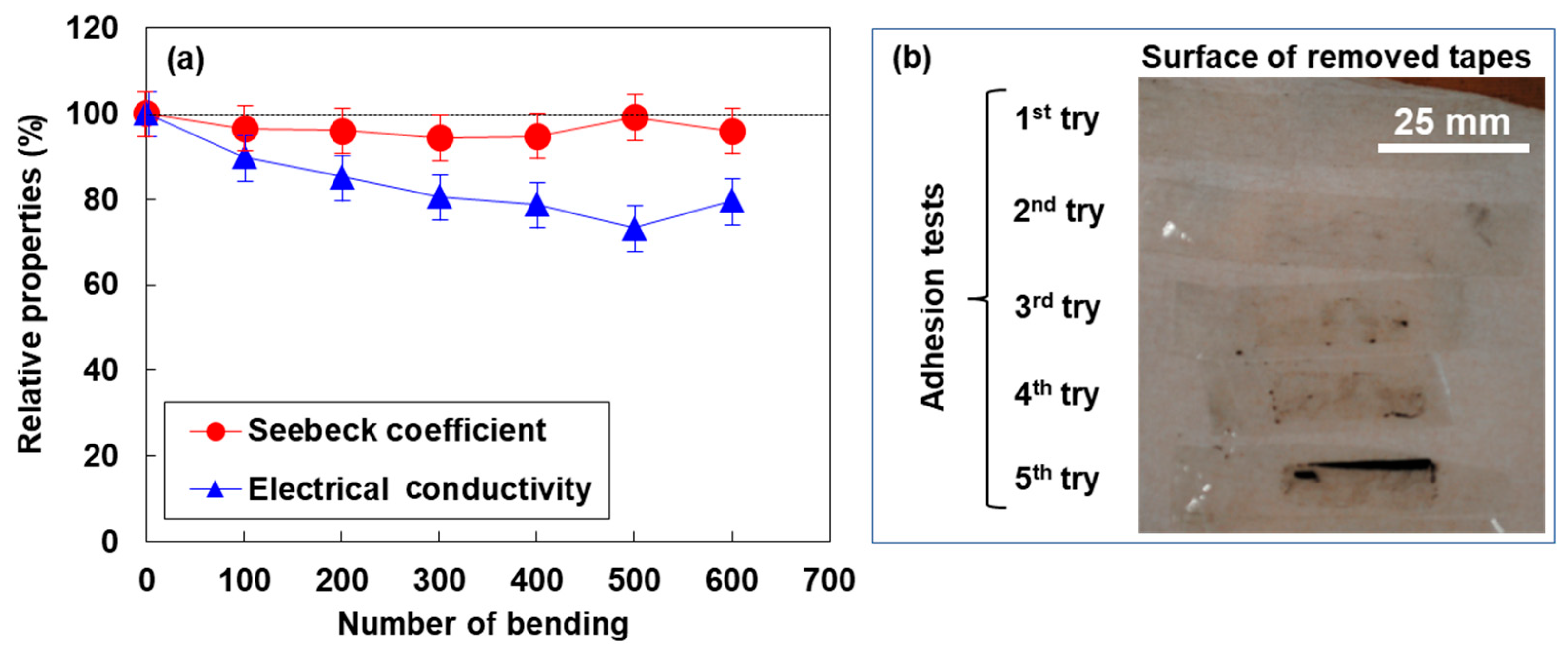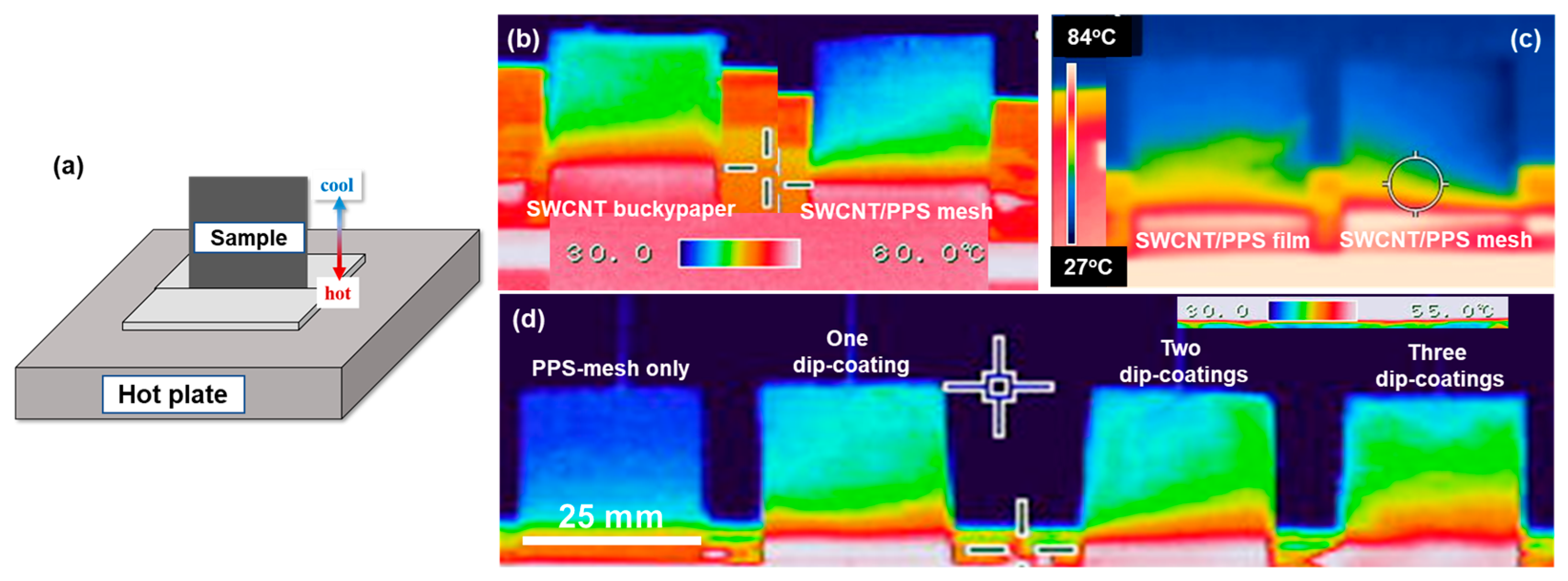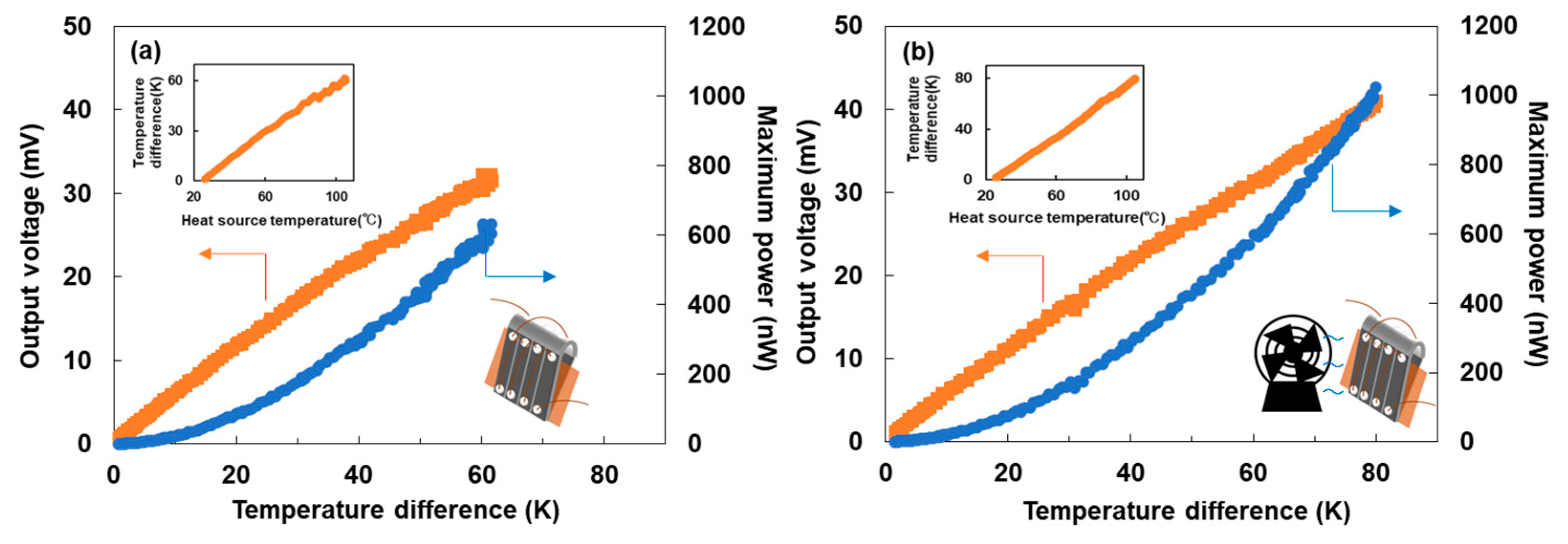Improved Heat Dissipation of Dip-Coated Single-Walled Carbon Nanotube/Mesh Sheets with High Flexibility and Free-Standing Strength for Thermoelectric Generators
Abstract
1. Introduction
2. Materials and Methods
3. Results and Discussion
3.1. Dip-Coated SWCNT/Mesh Sheets with Different Meshes
3.2. SWCNT/Mesh Sheets with Various Dip-Coatings
3.3. TEGs Using Dip-Coated SWCNT/Mesh Sheets
4. Conclusions
Supplementary Materials
Author Contributions
Funding
Institutional Review Board Statement
Informed Consent Statement
Data Availability Statement
Acknowledgments
Conflicts of Interest
References
- Ma, Z.; Wei, A.; Ma, J.; Shao, L.; Jiang, H.; Dong, D.; Ji, Z.; Wang, Q.; Kang, S. Lightweight, compressible and electrically conductive polyurethane sponges coated with synergistic multiwalled carbon nanotubes and graphene for piezoresistive sensors. Nanoscale 2018, 10, 7116. [Google Scholar] [PubMed]
- Hu, P.; Lyu, J.; Fu, C.; Gong, W.-B.; Liao, J.; Lu, W.; Chen, Y.; Zhang, X. Multifunctional aramid nanofiber/carbon nanotube hybrid aerogel films. ACS Nano 2022, 14, 688. [Google Scholar] [CrossRef]
- Wang, C.; Xia, K.; Wang, H.; Liang, X.; Yin, Z.; Zhang, Y. Advanced carbon for flexible and wearable electronics. Adv. Mater. 2019, 31, 1801072. [Google Scholar] [CrossRef]
- Nguyen, N.; Zhang, S.; Oluwalowa, A.; Park, J.G.; Yao, K.; Liang, R. High-performance and lightweight thermal management devices by 3D printing and assembly of continuous carbon nanotube sheets. ACS Appl. Mater. Interfaces 2018, 10, 27171. [Google Scholar]
- Dai, H. Carbon nanotubes: Opportunities and challenges. Surf. Sci. 2002, 500, 218. [Google Scholar] [CrossRef]
- Mamalis, A.G.; Vogtländer, G.O.L.; Markopoulos, A. Nanotechnology and nanostructured materials: Trends in carbon nanotubes. Precis. Eng. 2004, 28, 16. [Google Scholar]
- Huang, X.; Yin, Z.; Wu, S.; Qi, X.; He, Q.; Zhang, Q.; Yan, Q.; Boey, F.; Zhang, H. Graphene-based materials: Synthesis, characterization, properties, and applications. Small 2011, 7, 1876. [Google Scholar]
- Hossain, M.M.; Li, B.M.; Sennik, B.; Jur, J.S.; Bradford, P.D. Adhesive free, conformable and washable carbon nanotube fabric electrodes for biosensing. npj Flexible Electron. 2022, 6, 97. [Google Scholar]
- Iijima, S. Helical microtubules of graphitic carbon. Nature 1991, 354, 56. [Google Scholar]
- Jafari, Z.; Avargani, V.M.; Rahimi, M.R.; Mosleh, S. Magnetic nanoparticles-embedded nitrogen-doped carbon nanotube/porous carbon hybrid derived from a metal-organic framework as a highly efficient adsorbent for selective removal of Pb(II) ions from aqueous solution. J. Mol. Liq. 2020, 318, 113987. [Google Scholar] [CrossRef]
- Tang, D.-M.; Erohin, S.V.; Kvashnin, D.G.; Demin, V.A.; Cretu, O.; Jiang, S.; Zhang, L.; Hou, P.X.; Chen, G.; Futaba, D.N.; et al. Semiconductor nanochannels in metallic carbon nanotubes by thermomechanical chirality alteration. Science 2021, 374, 1616. [Google Scholar] [CrossRef] [PubMed]
- Tanaka, T.; Liu, H.; Fuji, S.; Kataura, H. From metal/semiconductor separation to single-chirality separation of single-wall carbon nanotubes using gel. Phys. Status Solidi RRL 2011, 5, 301. [Google Scholar] [CrossRef]
- Choi, J.; Jung, Y.; Yang, S.J.; Oh, J.Y.; Oh, J.; Jo, K.; Son, J.G.; Moon, S.E.; Park, C.R.; Kim, H. Flexible and robust thermoelectric generators based on all-carbon nanotube yarn without metal electrodes. ACS Nano 2017, 11, 7608. [Google Scholar] [CrossRef]
- Blackburn, J.L.; Ferguson, A.J.; Cho, C.; Grunlan, J.C. Carbon-nanotube-based thermoelectric materials and devices. Adv. Mater. 2018, 30, 1704386. [Google Scholar] [CrossRef] [PubMed]
- Zhang, Y.; Zhang, Q.; Chen, G. Carbon and carbon composites for thermoelectric applications. Carbon Energy 2020, 2, 408. [Google Scholar] [CrossRef]
- Chiba, T.; Amma, Y.; Takashiri, M. Heat source free water floating carbon nanotube thermoelectric generators. Sci. Rep. 2021, 11, 14707. [Google Scholar] [CrossRef] [PubMed]
- Konagaya, R.; Takashiri, M. Dual-type flexible-film thermoelectric generators using all-carbon nanotube films. Coatings 2023, 13, 13209. [Google Scholar] [CrossRef]
- Mytafides, C.K.; Tzounis, L.; Karalis, G.; Formanek, P.; Paipetis, A.S. High-power all-carbon fully printed and wearable SWCNT-based organic thermoelectric generator. ACS Appl. Mater. Interfaces 2021, 13, 11151–11165. [Google Scholar] [CrossRef]
- Vareli, I.; Tzounis, L.; Tsirka, K.; Kavvadias, I.E.; Tsongas, K.; Liebscher, M.; Elenas, A.; Gergidis, L.N.; Barkoula, N.-M.; Paipetis, A.S. High-performance cement/SWCNT thermoelectric nanocomposites and a structural thermoelectric generator device towards large-scale thermal energy harvesting. J. Mater. Chem. C 2021, 9, 14421–14438. [Google Scholar] [CrossRef]
- Macleod, B.A.; Stanton, N.J.; Gould, I.E.; Wesenberg, D.; Ihly, R.; Owczarczyk, Z.R.; Hurst, K.E.; Fewox, C.S.; Folmar, C.N.; Hughes, K.H.; et al. Large n- and p-type thermoelectric power factors from doped semiconducting single-walled carbon nanotube thin films. Energy Environ. Sci 2017, 10, 2168–2179. [Google Scholar] [CrossRef]
- Khongthong, J.; Raginov, J.N.; Khabushev, E.M.; Goldt, A.E.; Kondrashov, V.A.; Russakov, D.M.; Shandakov, S.D.; Krasnikov, D.V.; Nasibulin, A.G. Aerosol doping of SWCNT films with p- and n-type dopants for optimizing thermoelectric performance. Carbon 2024, 218, 118670. [Google Scholar] [CrossRef]
- Wada, K.; Tomita, K.; Takashiri, M. Fabrication of bismuth telluride nanoplates via solvothermal synthesis using different alkalis and nanoplate thin films by printing method. J. Cryst. Growth 2017, 468, 194–198. [Google Scholar]
- Liu, Y.; Du, Y.; Meng, Q.; Xu, J.; Shen, S.Z. Effects of preparation methods on the thermoelectric performance of SWCNT/Bi2Te3 bulk composites. Materials 2020, 13, 2636. [Google Scholar] [PubMed]
- Zoui, M.A.; Bentouba, S.; Stocholm, J.G.; Bourouis, M. A review on thermoelectric generators: Progress and applications. Energies 2020, 13, 3606. [Google Scholar] [CrossRef]
- Toan, N.V.; Truong, T.T.K.; Ono, T. Thermoelectric generators for heat harvesting: From material synthesis to device fabrication. Energy Convers. Manage. 2020, 225, 113442. [Google Scholar]
- Lee, E.A. The past, present and future of cyber-physical systems: A focus on models. Sensors 2015, 15, 4837. [Google Scholar]
- Du, Y.; Xua, J.; Paul, B.; Eklund, P. Flexible thermoelectric materials and devices. App. Mater. Today 2018, 12, 366. [Google Scholar] [CrossRef]
- Karthikeyan, V.; Surjadi, J.U.; Wong, J.C.K.; Kannan, V.; Lam, K.-H.; Chen, X.; Lu, Y.; Roy, V.A.L. Wearable and flexible thin film thermoelectric module for multi-scale energy harvesting. J. Power Sources 2020, 455, 227983. [Google Scholar]
- Wang, Y.; Zhu, W.; Deng, Y.; Fu, B.; Zhu, P.; Yu, Y.; Li, J.; Guo, J. Self-powered wearable pressure sensing system for continuous healthcare monitoring enabled by flexible thin-film thermoelectric generator. Nano Energy 2020, 73, 075216. [Google Scholar]
- Kobayashi, A.; Konagaya, R.; Tanaka, S.; Takashiri, M. Optimized structure of tubular thermoelectric generators using n-type Bi2Te3 and p-type Sb2Te3 thin films on flexible substrate for energy harvesting. Sens. Actuators A 2020, 313, 112199. [Google Scholar] [CrossRef]
- Liu, W.-D.; Yin, L.-C.; Li, L.; Yang, Q.; Wang, D.-Z.; Li, M.; Shi, X.-L.; Liu, Q.; Bai, Y.; Gentle, I.; et al. Grain boundary re-crystallization and sub-nano regions leading to high plateau figure of merit for Bi2Te3 nanoflakes. Energy Environ. Sci. 2023, 16, 5123–5135. [Google Scholar] [CrossRef]
- Kato, K.; Hatasako, Y.; Uchino, M.; Nakata, Y.; Suzuki, Y.; Hayakawa, T.; Adachi, C.; Miyazaki, K. Flexible porous bismuth telluride thin films with enhanced figure of merit using micro-phase separation of block copolymer. Adv. Mater. Interfaces 2014, 1, 1300015. [Google Scholar] [CrossRef]
- Kashiwagi, M.; Hirata, S.; Harada, K.; Zheng, Y.; Miyazaki, K.; Yahiro, M.; Adachi, C. Enhanced figure of merit of a porous thin film of bismuth antimony telluride. Appl. Phys. Lett. 2011, 98, 023114. [Google Scholar] [CrossRef]
- Avery, A.D.; Zhou, B.H.; Lee, J.; Lee, E.-S.; Miller, E.M.; Ihly, R.; Wesenberg, D.; Mistry, K.S.; Guillot, S.L.; Zink, B.L.; et al. Tailored semiconducting carbon nanotube networks with enhanced thermoelectric properties. Nat. Energy 2016, 1, 16033. [Google Scholar] [CrossRef]
- Hasan, M.N.; Nafea, M.; Nayan, N.; Ali, M.S.M. Thermoelectric generator: Materials and applications in wearable health monitoring sensors and Internet of Things devices. Adv. Mater. Technol. 2021, 7, 2101203. [Google Scholar] [CrossRef]
- Komatsu, N.; Ichinose, Y.; Dewey, O.S.; Taylor, L.W.; Trafford, M.A.; Yomogida, Y.; Wehmeyer, G.; Pasquali, M.; Yanagi, K.; Kono, J. Macroscopic weavable fibers of carbon nanotubes with giant thermoelectric power factor. Nat. Commun. 2021, 12, 4931. [Google Scholar] [CrossRef]
- Nonoguchi, Y.; Nakano, M.; Murayama, T.; Hagino, H.; Hama, S.; Miyazaki, K.; Matsubara, R.; Nakamura, M.; Kawai, T. Simple salt-coordinated n-type nanocarbon materials stable in air. Adv. Funct. Mater. 2016, 18, 3021. [Google Scholar] [CrossRef]
- Horike, S.; Wei, Q.; Akaike, K.; Kirihara, K.; Mukaida, M.; Koshiba, Y.; Ishida, K. Bicyclic-ring base doping induces n-type conduction in carbon nanotubes with outstanding thermal stability in air. Nat. Commun. 2022, 13, 3517. [Google Scholar] [CrossRef]
- Seki, Y.; Nagata, K.; Takashiri, M. Facile preparation of air-stable n-type thermoelectric single-wall carbon nanotube films with anionic surfactants. Sci. Rep. 2020, 10, 8104. [Google Scholar] [CrossRef]
- Nakashima, Y.; Yamaguchi, R.; Toshimitsu, F.; Matsumoto, M.; Borah, A.; Staykov, A.; Islam, M.S.; Hayami, S.; Fujigaya, T. Air-stable n-type single-walled carbon nanotubes doped with benzimidazole derivatives for thermoelectric conversion and their air-stable mechanism. ACS Appl. Nano Mater. 2019, 2, 4703. [Google Scholar] [CrossRef]
- Amma, Y.; Miura, K.; Nagata, S.; Nishi, T.; Miyake, S.; Miyazaki, K.; Takashiri, M. Ultra-long air-stability of n-type carbon nanotube films with low thermal conductivity and all-carbon thermoelectric generators. Sci. Rep. 2022, 12, 21603. [Google Scholar] [CrossRef]
- Hwang, H.; Jang, K.-S. Thermoelectric all-carbon heterostructures for a flexible thermoelectric generator. Sustain. Energy Fuels 2021, 5, 267–273. [Google Scholar] [CrossRef]
- Lee, T.; Park, K.T.; Ku, B.-C.; Kim, H. Carbon nanotube fibers with enhanced longitudinal carrier mobility for high-performance all-carbon thermoelectric generators. Nanoscale 2019, 11, 16919–16927. [Google Scholar] [CrossRef]
- Behabtu, N.; Young, C.C.; Tsentalovich, D.E.; Kleinerman, O.; Wang, X.; Ma, A.W.; Bengio, E.A.; Ter Waarbeek, R.F.; De Jong, J.J.; Hoogerwerf, R.E.; et al. Strong, light, multifunctional fibers of carbon nanotubes with ultrahigh conductivity. Science 2013, 339, 182. [Google Scholar] [CrossRef]
- Seki, Y.; Takashiri, M. Freestanding bilayers of drop-cast single-walled carbon nanotubes and electropolymerized poly(3,4-ethylenedioxythiophene) for thermoelectric energy harvesting. Org. Electron. 2020, 76, 105478. [Google Scholar] [CrossRef]
- Grosso, D. How to exploit the full potential of the dip-coating process to better control film formation. J. Mater. Chem. 2011, 21, 17033. [Google Scholar] [CrossRef]
- Seki, Y.; Takahashi, M.; Takashiri, M. Effects of different electrolytes and film thicknesses on structural and thermoelectric properties of electropolymerized poly(3,4-ethylenedioxythiophene) films. RSC Adv. 2019, 9, 15957. [Google Scholar] [CrossRef]
- Li, X.; Cai, K.; Gao, M.; Du, Y.; Shen, S. Recent advances in flexible thermoelectric films and devices. Nano Energy 2020, 89, 106309. [Google Scholar]
- Zeng, F.; Zhao, X.; Luo, M.; Wang, W.; Qing, X.; Lu, Y.; Zhong, W.; Liu, Q.; Luo, L.; Li, M.; et al. A transparent PEDOT:PPS/PVA-co-PE/epoxy thermoelectric composite device with excellent flexibility and environmental stability. Compos. Sci. Technol. 2022, 218, 109153. [Google Scholar] [CrossRef]
- Yu, P.; Feng, L.; Tang, W.; Liu, C.; Lan, J.-L.; Lin, Y.-H.; Yang, X. Robust, flexible thermoelectric film for energy harvesting by a simple and eco-friendly method. ACS Appl. Mater. Interfaces 2023, 15, 13144–13154. [Google Scholar] [CrossRef]
- Kim, J.Y.; Ahn, K.; Jeong, S.Y.; Jeong, E.D.; Jin, J.S.; Bae, J.S.; Kim, H.G.; Cho, C.R. Enhancement of adhesion between polyphenylene sulfide and copper by surface treatments. Curr. Appl. Phys. 2014, 14, 118. [Google Scholar] [CrossRef]
- Inagaki, N.; Narushima, K.; Morita, M. Plasma surface modification of poly(phenylene sulfide) films for copper metallization. J. Adhes. Sci. Technol. 2006, 20, 917–938. [Google Scholar]
- Anagreh, N.; Dorn, L.; Bilke-Krause, C. Low-pressure plasma pretreatment of polyphenylene sulfide (PPS) surfaces for adhesive bonding. Int. J. Adhes. Adhes. 2008, 28, 16–22. [Google Scholar] [CrossRef]
- Xu, D.; Yang, W.; Li, X.; Hu, Z.; Li, M.; Wang, L. Surface nanostructure and wettability inducing high bonding strength of polyphenylene sulfide-aluminum composite structure. Appl. Surf. Sci. 2020, 515, 145996. [Google Scholar] [CrossRef]
- Nguyen, T.P.; Lahmar, A.; Jonnard, P. Adhesion improvement of poly(phenylene-vinylene) substrates induced by argon-oxygen plasma treatment. J. Adhes. 1998, 66, 303–317. [Google Scholar]
- Carlson, E.J.; Strunz, K.; Otis, B.P. A 20 mV input boost converter with efficient digital control for thermoelectric energy harvesting. IEEE J. Solid-State Circuits 2010, 45, 741. [Google Scholar] [CrossRef]






| Mesh Type | σ [S/cm] | S [μV/K] | σS2 [μW/(m·K2)] | Flexibility | Free-Standing Strength | Ref. |
|---|---|---|---|---|---|---|
| SWCNT/PPS-mesh | 7.2 | 61.9 | 2.8 | Excellent | Excellent | This work |
| SWCNT/PVC-mesh | No evaluation due to incomplete coating | This work | ||||
| SWCNT/PP-mesh | 7.4 | 48.1 | 1.7 | Excellent | Poor | This work |
| SWCNT buckypaper | 41 | 53 | 12 | Excellent | Average | [17] |
| Numbers of Dip-Coating at SWCNT/PPS | Wire Diameter [μm] | SWCNT Thickness [μm] | * Flexibility | σ [S/cm] | S [μV/K] | σS2 [μW/(m·K2)] |
|---|---|---|---|---|---|---|
| One | 40 | 3 | Excellent | 7.2 | 61.9 | 2.8 |
| Two | 52 | 9 | Average | 7.4 | 63.2 | 3.0 |
| Three | 60 | 13 | Poor | Not measurable due to cracking | ||
Disclaimer/Publisher’s Note: The statements, opinions and data contained in all publications are solely those of the individual author(s) and contributor(s) and not of MDPI and/or the editor(s). MDPI and/or the editor(s) disclaim responsibility for any injury to people or property resulting from any ideas, methods, instructions or products referred to in the content. |
© 2024 by the authors. Licensee MDPI, Basel, Switzerland. This article is an open access article distributed under the terms and conditions of the Creative Commons Attribution (CC BY) license (https://creativecommons.org/licenses/by/4.0/).
Share and Cite
Miura, K.; Amezawa, T.; Tanaka, S.; Takashiri, M. Improved Heat Dissipation of Dip-Coated Single-Walled Carbon Nanotube/Mesh Sheets with High Flexibility and Free-Standing Strength for Thermoelectric Generators. Coatings 2024, 14, 126. https://doi.org/10.3390/coatings14010126
Miura K, Amezawa T, Tanaka S, Takashiri M. Improved Heat Dissipation of Dip-Coated Single-Walled Carbon Nanotube/Mesh Sheets with High Flexibility and Free-Standing Strength for Thermoelectric Generators. Coatings. 2024; 14(1):126. https://doi.org/10.3390/coatings14010126
Chicago/Turabian StyleMiura, Katsuma, Takuya Amezawa, Saburo Tanaka, and Masayuki Takashiri. 2024. "Improved Heat Dissipation of Dip-Coated Single-Walled Carbon Nanotube/Mesh Sheets with High Flexibility and Free-Standing Strength for Thermoelectric Generators" Coatings 14, no. 1: 126. https://doi.org/10.3390/coatings14010126
APA StyleMiura, K., Amezawa, T., Tanaka, S., & Takashiri, M. (2024). Improved Heat Dissipation of Dip-Coated Single-Walled Carbon Nanotube/Mesh Sheets with High Flexibility and Free-Standing Strength for Thermoelectric Generators. Coatings, 14(1), 126. https://doi.org/10.3390/coatings14010126







